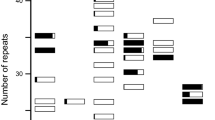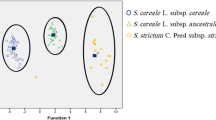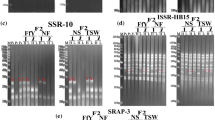Abstract
Twenty populations of Lolium perenne originating from a range of habitats in Europe were compared for isoenzyme polymorphisms and agronomically important quantitative traits in order to establish relationships of the levels of diversity with the origin of each population and to assess their suitability to be included in the European core collection of Lolium germplasm. Forty genotypes from each of the twenty populations and each genotype represented by three clonal propagules, were field planted in a fully randomized spaced plant design and fifteen quantitative characters including yield, persistency, reproductive and disease resistence characters were evaluated over a period of two years. Seven putative isozyme loci were assayed to compare the allozyme divergence of populations. The results of the isozyme survey indicate that 71–100% of the loci were polymorphic, 2.3–3.0 alleles/locus and the gene diversity was varying from 0.234–0.410. Of the total allelic diversity 94% remained within populations (Hs) whilst only 6% was distributed among populations (Dst). The differences between populations were determined on the basis of allele frequencies and multivariate analyses of quantitative characters. Populations significantly differed in their allele frequencies at all loci analysed. Random mating was predominant in all populations at most of the loci. The study revealed that the German accession BA 10998 was clearly distinct from the rest both in quantitative characters and allele frequencies. German accession BA 11015 with the lowest gene diversity showed the highest genetic variation for quantitative characters. However, no strict relationship was found between the genetic distance and the geograpical distribution of the populations. Among the quantitative characters, flowering time showed a strong relationship with the type of management practised at the collection site than their place of origin.
Similar content being viewed by others
References
Brouquisse, R.M., J. Nishimura & R.D. Gaillard, 1987. Characterization of cytosolic aconitase in higher plant cells. Plant Physiol 84: 1402–1407.
Brown, A.H.D., 1990. The role of isozyme studies in molecular systematics. Austral Syst Bot 3: 39–46.
Crawford, D.J., 1990. Plant Molecular Systematics. John Wiley, New York.
Fernando, W.M.U., 1992. A biometrical and population genetic study of Lolium perenne. Ph.D thesis, University of Birmingham.
Gottlieb, L.D., 1981. Electrophoretic evidence and plant populations. Progr Phytochem 7: 1–46.
Hamrick, J.L., 1979. Genetic variation and life cycles. In: O. Soldbrig, S. Jain, G. Johnson & P. Ravan (Eds.), Topics in Plant Population Biology, pp. 84–113. Columbia U.P., New York.
Hamrick, J.L., 1989. Isozymes and the analysis of genetic structure in plant populations. In: D.E. Soltis & P.S. Soltis (Eds.), Isozymes in Plant Biology. Discorides Press, Portland, Oregon.
Hayward, M.D. & N.J. McAdam, 1977. Isozyme polymorphisms as a measure of distinctiveness and stability in cultivars of Lolium perenne. Z Pflanzenzüchtg 79: 59–68.
Hayward, M.D. & N.J. McAdam, 1985. Rep Welsh Pl Breeding Stn for 1984, pp. 36–38.
Jones, T.W.A., 1984. Development of phosphoglucoisomerase isozymes in perennial ryegrass (Lolium perenne). Physiol Plant 60: 203–207.
Marshall, D.R. & A.H.D. Brown, 1975. Optimum sampling strategies in genetic conservation. In: O.H. Frankel & J.G. Hawkes (Eds.), Crop Genetic Resources for Today and Tomorrow, pp. 53–80. Camb Univ Press, Cambridge.
Marshall, D.R. & A.H.D. Brown, 1983. Theory of forage plant collection. In: J.G. McIvor & R.A. Bray (Eds.), Genetic Resources of Forage Plants, pp. 136–148. CSIRO, Australia.
Nei, M., 1972. Genetic distance between populations. Amer Natur 106: 283–292.
Nei, M., 1973a. Analysis of gene diversity in subdivided populations. Proc Nat Acad Sci 70: 3321–3323.
Tyler, B.F., K.H. Chorlton & I.D. Thomas, 1987. Collection and field sampling techniques for forages. In: B.F. Tyler (Ed.), Collection Characterization and Utilization of Genetic Resources of Temperate Forage Grass and Clover. IBPGR Training Course: Lectures Series 1, IBPGR, Rome.
Wendal, J.F. & N.F. Weeden, 1989. Visualization and interpretation of plant isozymes. In: D.S. Soltis & P.S. Soltis (Eds.), Isozymes in Plant Biology, pp. 5–45. Dioscorides Press, Portland, Oregon.
Author information
Authors and Affiliations
Rights and permissions
About this article
Cite this article
Ursla Fernando, W., Hayward, M. & Kearsey, M. Isozyme and quantitative traits polymorphisms in European provenances of perennial ryegrass (Lolium perenne L). Euphytica 93, 263–269 (1997). https://doi.org/10.1023/A:1002988617100
Issue Date:
DOI: https://doi.org/10.1023/A:1002988617100




